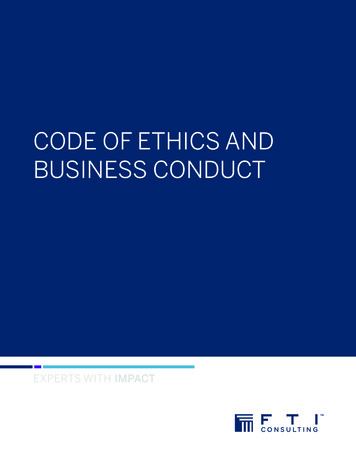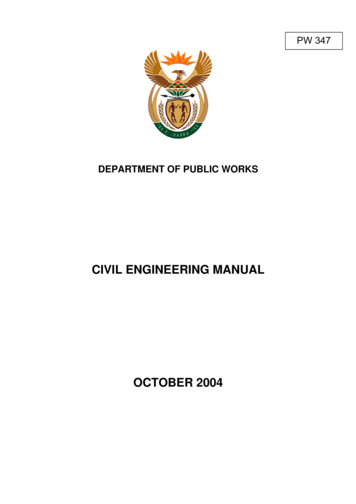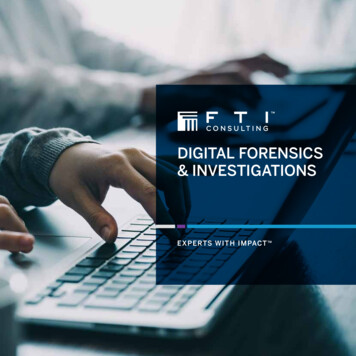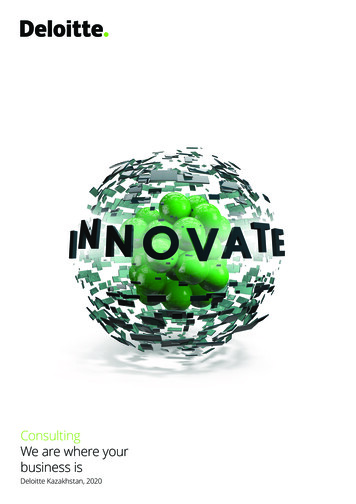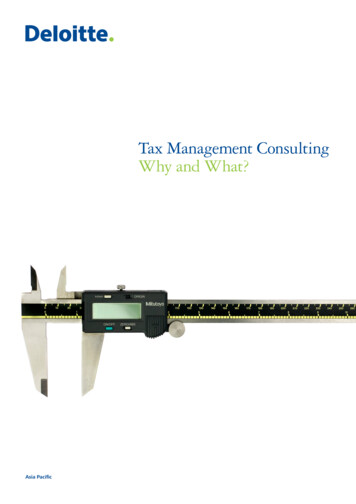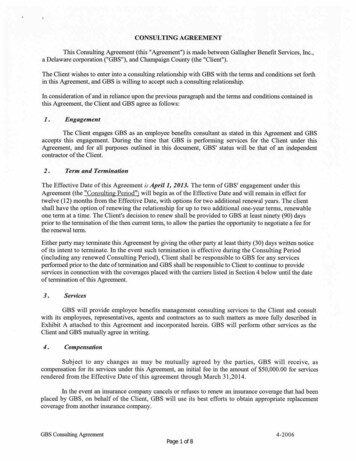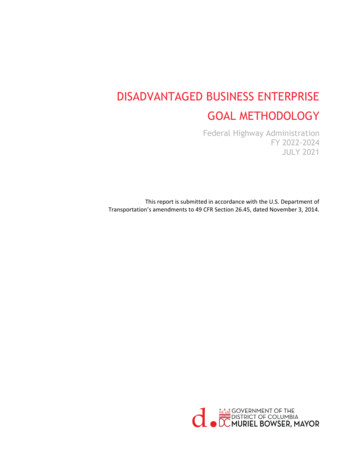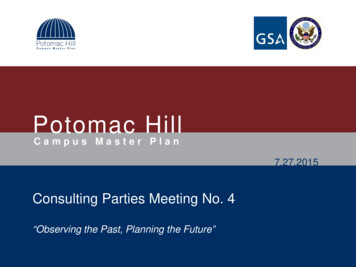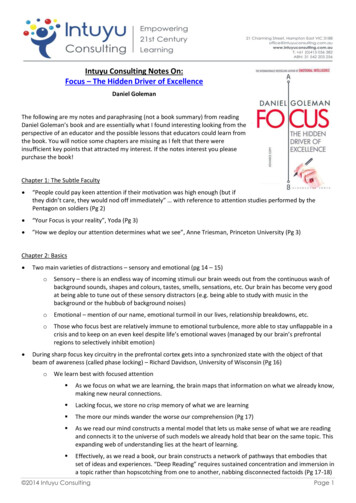
Transcription
Intuyu Consulting Notes On:Focus – The Hidden Driver of ExcellenceDaniel GolemanThe following are my notes and paraphrasing (not a book summary) from readingDaniel Goleman’s book and are essentially what I found interesting looking from theperspective of an educator and the possible lessons that educators could learn fromthe book. You will notice some chapters are missing as I felt that there wereinsufficient key points that attracted my interest. If the notes interest you pleasepurchase the book!Chapter 1: The Subtle Faculty “People could pay keen attention if their motivation was high enough (but ifthey didn’t care, they would nod off immediately” with reference to attention studies performed by thePentagon on soldiers (Pg 2) “Your Focus is your reality”, Yoda (Pg 3) ”How we deploy our attention determines what we see”, Anne Triesman, Princeton University (Pg 3)Chapter 2: Basics Two main varieties of distractions – sensory and emotional (pg 14 – 15)oSensory – there is an endless way of incoming stimuli our brain weeds out from the continuous wash ofbackground sounds, shapes and colours, tastes, smells, sensations, etc. Our brain has become very goodat being able to tune out of these sensory distractors (e.g. being able to study with music in thebackground or the hubbub of background noises)oEmotional – mention of our name, emotional turmoil in our lives, relationship breakdowns, etc.oThose who focus best are relatively immune to emotional turbulence, more able to stay unflappable in acrisis and to keep on an even keel despite life’s emotional waves (managed by our brain’s prefrontalregions to selectively inhibit emotion)During sharp focus key circuitry in the prefrontal cortex gets into a synchronized state with the object of thatbeam of awareness (called phase locking) – Richard Davidson, University of Wisconsin (Pg 16)oWe learn best with focused attention As we focus on what we are learning, the brain maps that information on what we already know,making new neural connections. Lacking focus, we store no crisp memory of what we are learning The more our minds wander the worse our comprehension (Pg 17) As we read our mind constructs a mental model that lets us make sense of what we are readingand connects it to the universe of such models we already hold that bear on the same topic. Thisexpanding web of understanding lies at the heart of learning. Effectively, as we read a book, our brain constructs a network of pathways that embodies thatset of ideas and experiences. “Deep Reading” requires sustained concentration and immersion ina topic rather than hopscotching from one to another, nabbing disconnected factoids (Pg 17-18) 2014 Intuyu ConsultingPage 1
Chapter 3: Attention Top and Bottom Brain has two semi-independent, largely separate mental systems (pg 24 ff)oBottom-up mind (Unconscious cognitive biases) Massive computing power operating constantly solving ourproblems Involuntary and automatic (we are blind to its workings) Operates through networks of association – intuitive Driven by emotions – impulsive Executor of habitual routines Manager of our mental models of the world Multi-tasking and analyses what is in our perceptual field before letting us know what it selectsas relevant In original design of the brain (millions of years ago) that favours short-term thinking, impulseand speedy decisions Worked well for basic survival but systemic poor habits (overeating, gambling, addictions, etc)are signs that the system is “out of whack” Requires low power to run thus takes priorityoTop-down mind (Conscious Awareness – where intentionality lies) Refers to mental activity mostly within the neocortex that can monitor and impose its goals onthe bottom-down mind (executive functioning) Slower Voluntary and effortful Seat of self-control which can over-ride automatic routines and emotionally driven impulses Able to learn new models, new plans and take charge of our automaticity to an extent Takes things one at a time and applies more thoughtful analysis Evolved later on (hundreds of thousands of years ago) and adds talents like self-awareness,reflection, deliberation and planning to our skills. It is the driver of the engine which is thebottom up thinking machinery. Is energy consuming (high power) so does not do this for long Cognitive efforts like learning demand active attentionoThe bottom/top systems distribute mental tasks between them so we can make minimal efforts and getoptimal results. The more we practice and ritualize a routine the more the routine gets passed off fromthe top-down mind to the bottom-up mind until it becomes automatic. As we develop mastery of aparticular skill the less cognitive effort is required to perform it, thus freeing our attention for the extrasseen only among those at the top levels. The more you can relax and trust in bottom-up actions(expertise), the more you free your mind to be nimble. (pg 28)Overloading attention shrinks mental control. More errors occur when we are distracted, stressed orotherwise mentally burdened. In those circumstances, a cognitive control system that ordinarilymonitors errors we might make can inadvertently act as a mental prime, increasing the likelihood of thatmistake.o The bottom-up circuitry learns voraciously and quietly taking in lessons continually throughout our day. While itworks well most of the time, our emotions and our motives create skews and biases in our attention that wetypically, because it is unconscious, don’t notice. Bottom-up awareness makes us suckers for subconscious priming (e.g. happy smiling faces in the fleetingbackground of an ad for a drink primes us to drink more) 2014 Intuyu ConsultingPage 2
Emotional resilience comes down to how quickly we recover from upsets. People who are highly resilient havedeveloped their left pre-frontal area (part of our top down mechanism) to overcome any hijacking by ouremotions. Active engagement in attention (self-awareness and metacognition) inhibits mindless mental habits.Chapter 4: The Value of a Mind Adrift Conversely, our mind being adrift is in some ways the default mode of our brain and it allows our creative juicesto flow (which are restricted when we are focused and requiring cognitive control). Among the positive functionsof a mind wandering are generating scenarios for the future, self-reflection, navigating a complex social world,incubation of creative ideas and giving our circuitry for more intensive focusing a refreshing break (Pg 40-41) Open awareness creates a mental platform for creative breakthroughs and unexpected insights. Once we havehit upon a great creative insight we need to switch to a keen focus on how to apply it. Serendipity comes withopenness to possibility, then homing in on putting it to use. Classic model of the stages of creativity roughly translates to three modes of focus:oOrienting – where we search out and immerse ourselves in all kinds of inputoSelective attention – on the specific creative challengeoOpen awareness – where we associate freely to let the solution emerge In a complex world where almost everyone has access to the same information, new value arises from theoriginal synthesis, from putting ideas together in novel ways, from smart questions that open up untappedpotential. Creative insights entail joining elements in a useful, fresh way. Open time lets the creative spirit flourish, tight schedules kill it. Harvard Business Study “The power of small wins” found that creative insights flowed best when people hadclear goals but also the freedom in how they reached them. And, the most crucial, they had protected time –enough to think freely. The key to breakthroughs in thinking is having small wins – minor innovations andtroubling problems solved – on concrete steps towards a larger goalChapter 5: Finding Balance It is not the chatter of people around us that is the most powerful distractor, but rather the chatter of ourown minds. Utter concentration demands these inner voices be stilled. Mindfulness – when we turn our full attention to our senses – quiets the default chatter of the mind, itquiets the brain circuitry for me-focused mental chatter (pg 49) At the neural level mind wandering and perceptual awareness tend to inhibit each other: internal focus onour train of thought tunes out the senses. This tune-out can be total, as when we get utterly lost in what weare doing. Situations that do not demand constant task-focus – particularly boring or routine ones – free the mind towander. As the mind drifts off and the default network activates more strongly, our neural circuits for taskfocus go quiet. An even keel in attention reflects a mental mode where we simply notice whatever comes into awarenesswithout getting caught up or swept away by any particular thing. “The capacity to remain with yourattention open in a panoramic awareness lets you attend with equanimity, without getting caught in abottom-up capture that ensnares the mind in judging and reactivity (where we become fixated on somethingto the exclusion of everything else), whether negative or positive.” (pg 55) 2014 Intuyu ConsultingPage 3
Tightly focused attention gets fatigued – much like an overworked muscle – when we push to the point ofcognitive exhaustion. The signs of mental fatigue, such as a drop in effectiveness and the rise ofdistractedness and irritability, signify that the mental effort needed to sustain focus has depleted the glucosethat feeds neural energy. To restore our mental energy we need to switch from effortful attention, where the mind needs to suppressdistractions, to letting go and allowing our attention to be captured by whatever presents itself.Disengagement is the first step. Fully focusing on something relaxing where we arouse the sensory systems(walking in the park, playing with your children, nothing that requires effortful focus)Chapter 6: The Inner Rudder What allows people to have a strong inner compass and confidence in one’s own guiding values? Selfawareness, particularly accuracy in decoding the internal cues of our body’s murmurs, holds the key. Oursubtle physiological reactions reflect the sum total of our experience relevant to the decision at hand. Inbeing aware and present to our own reactions makes the difference between a life well lived and one thatfalters.Steve Jobs “Don’t let the voice of others’ opinions drown out your inner voice. And most important, have thecourage to follow your heart and intuition. They somehow already know what you truly want to become”Our “gut feelings” are messages from the insula (which maps our body’s insides via circuitry linking to ourgut, heart, liver, lungs, and genitals) and other bottom-up circuits that simplify life decisions for us by guidingour attention towards smarter options. The better we are at reading these messages, the better ourintuition. (pg 66)Chapter 7: Seeing ourselves as others see us One surefire test for self-awareness is a 360 degree evaluation. The gap between how you see yourself andhow others rate you offers one of the best evaluations you can get anywhere of your own self-awareness. Self-awareness appears to diminish with promotions up the organizational ladder. This may be because thehigher people rise in an organization the smaller the circle of others willing or courageous enough to speakto them honestly about their quirks. Our sense of self dawns in our social interactions; others are our mirrors, reflecting us back to ourselves. Inessence, “I am what I think you think I am” Not only do we not see ourselves as others see us, we don’t hear ourselves as others hear us. When peoplereceive negative performance feedback in a warm supportive tone of voice, they leave feeling positive –despite the negative feedback. But when they positive performance reviews in a cold and distant tone ofvoice, they end up feeling bad despite the good news (pg 71) When the tendency to ignore evidence to the contrary spreads into a shared self-deception, it becomesgroupthink. The unstated need to protect a treasured opinion (by discounting crucial disconfirming data)drives shared blind spots that lead to bad decisions. (pg 72) It takes meta-cognition – in this case, awareness of our lack of awareness – to bring to light what the grouphas buried in a grave of indifference or suppression. Clarity begins with realizing what we do not notice – anddon’t notice that we don’t notice. Candid feedback from those you trust and respect creates a source of self-awareness, one that can helpguard against skewed information inputs or questionable assumptions. Another antidote to groupthink: expand your circle of connection beyond your comfort zone and inoculateagainst in-group isolation by building an ample circle of no-BS confidants who keep you honest. 2014 Intuyu ConsultingPage 4
Chapter 8: A Recipe for Self Control Our mind deploys self-awareness to keep everything we do ontrack:oMeta-cognition – thinking about thinking – lets us knowhow our mental operations are going and adjusts themas neededoMeta-emotion does the same with regulating the flow offeeling and impulseoIn the mind’s design, self-awareness is built intoregulating our own emotions, as well as sensing what others feel.Executive attention (cognitive control) holds the key to self-management.oHow we focus holds the key to willpower. There are 3 sub-varieties of attention, all aspects of theexecutive, which are at play when we pit self-restraint against instant gratification. This is whatwillpower is. Ability to voluntarily disengage our focus from an object of desire that powerfully grabs ourattention Ability to resist distraction and keep our focus elsewhere Ability to keep our focus on a goal in the futureoIn a New Zealand project 1037 children were tracked over decades to determine the impact of selfcontrol on their health, wealth and public safety. What emerged was that willpower was anindependent force in life success – in fact, for financial success, self-control in childhood proved astronger predictor than either IQ or social class of the family of origin. The better the self-control inchildhood, the sounder their health, finances, and their relationship to crime and the law.oAnything we can do to increase children’s capacity for cognitive control will help them throughoutlife.oAttention, cognitive science tells us, has a limited capacity: working memory creates a bottleneckthat lets us hold just so much in our mind at any given moment. As our worries intrude on thelimited capacity of our attention, these irrelevant thoughts shrink the bandwidth left for learning.The ability to notice that we are getting anxious and to take steps to renew our focus rests on selfawareness.oWillpower keeps us focused on our goals despite the tug of our impulses, passions, habits andcravings. For example, those who have been most successful at losing weight and keeping it offexhibit the most cognitive control when facing a calorie laden morsel. (pg 88)Chapter 10: The Empathy Triad Three aspects of empathy (the ability to focus on what other people experience)oCognitive empathy – allows us to take other people’s perspective, comprehend their mental state,and at the same time manage our own emotions while we take stock of theirs. It helps us chooselanguage that fits their way of understanding.oEmotional empathy – means we join the other person in feeling along with them; our bodyresonates in whatever key of joy or sorrow the person is going through 2014 Intuyu ConsultingPage 5
oEmpathetic concern – leads us to care about the person, mobilizing us to help if need be and buildsupon the caring and attachment bottom-up systems we have. Our circuitry for empathy was designed for face-to-face interactions so online interactions pose specialchallenges. We rely more on cognitive empathy in non-face-to-face interactions Cognitive Empathy oMostly a top-down mental operationoAn inquisitive nature, which predisposes us to learnfrom everybody, feeds our cognitive empathy,amplifying our understanding of other people’sworlds. In bloom’s around two – five yrs of age andcontinues to develop through the teen years. Itshares circuitry with executive attention. However, tounderstand the feelings of others you need tounderstand your own feelings. (pg 100)Emotional EmpathyoOperates bottom-up and has its ancient roots in evolution, thus we share this circuitry with othermammals. It is a social connection empathy.oThese circuits tune in by arousing in our own body the emotional state picked up in the other personoStory telling can intimately couple listeners with the storyteller. The more overlap in the neuralcoupling between a storyteller and listener the better the listener’s understanding of the story.oSuch a shared rapport and connection between a learner and the teacher can put the child’s brain inthe best mode for learningoBegins to operate in early infancy and its capacity can develop like a muscle as we tune into others’feelings as we come to sense facial, vocal and other signals face-to-faceoWe can become good readers of others emotions by tuning in to ourselves because as our emotionalempathy capacity grows our body can mirror others’ emotions in our body. Thus the more selfaware we become, tuned into our own emotions, the more we can have emotional empathy forothers.Empathetic ConcernoCompassion builds on empathy, which in turn requires a focus on others. If self-absorbed we simplydo not notice other people.oIn mammals this circuitry compels attention and concern towards babies and the young and arisesmore strongly when we become parents.oIt is a double-edged feeling (having both bottom-up and top-down aspects) where there is implicitdiscomfort from the direct experience in one person of the distress of the other combined with thesocial evaluation of how much we value the other person’s well-being. Getting this top-down /bottom-up mix right makes a profound difference for people in helping professions to have abalanced approach to empathy for the people they are helping.oThe more we are distracted (or tired) the less we can exhibit attunement and caring. The need tocompete can sometimes suppress empathetic concern as well.The more empathetic the interaction the more a person feels heard and cared for. However, there are timeswe need to be able to insulate the brain from experiencing the wash of emotion such that we can stay calmand concentrate on what needs to be done when certain emotional circumstances. 2014 Intuyu ConsultingPage 6
Chapter 11: Social Sensitivity The ability to be social sensitive, be aware of social cues, appears related to cognitive empathy. The ability topick up implicit norms quickly enables a person to learn the unique mental models of a given culture. Culture aside, ground rules shift greatly depending on whom you are with. We can have different social cuesand norms within different communities that we belong to. What may be appropriate in one communitymay not be appropriate in another. Attention to context lets us pick up the subtle social cues that can guidehow we behave. Attention to implicit norms is largely intuitive, a bottom-up capacity. People who excel at organizational influence can not only sense the flow of personal connections but alsonames the people whose opinions hold the most sway – and so, when they need to, focus on convincingthose who will in turn persuade others. There are invisible signs of social status and powerlessness – the powerful tend to tune out the powerless –and that deadens empathy (pg 122)o We focus on the people we value mosto Poor people are particularly attentive to other people and their needs because they depend on goodrelationships with friends and family whom you may need to turn to for help (pg 123)o Wealth people can afford to be less aware of the needs of other people and so can be less attentiveto them and their sufferingo The more you care about someone, the more attention you pay – and the more attention you pay,the more you care. Attention interweaves with love. (pg 125)Chapter 13: System Blindness In a system there are no “side effects” – just effects, anticipated or not. Quite often we are blind to thedynamics of the system because we are not aware of the whole system. In a complex system cause and effect may be more distant in time and space than we realise. One of the worst results of system blindness occurs when leaders implement a strategy to solve a problem –but ignore the pertinent system dynamics (the possible causes of the problems)oE.g. shortsighted solution to traffic jams is to build more and wider roads – which leads to short-termrelief but over the long term leads to more jams and delay and mass transport loses viability. Ourincomplete mental models about traffic jams arises because we fail to take into account the systemdynamics of road systems (pg 142 – 143)oOur perceptions and mental models are tuned andmolded by what helped our forerunners survive in thewild but not to the systemic effects humans are havingon our environment (thus the rejection by some of theeffect of humans on the world – our mental modelsperceive the local not the systemic effect)oThe amydala (part of the flight-or-fight circuitry) onlydeals with immediate threats – not long term ones. Ourmental models leave us to be frogs in a pot of waterwhose temperature is increasing bit by bit until we arecooked! 2014 Intuyu ConsultingPage 7
Chapter 14: Distant Threats Negative focus leads to discouragement and disengagement. When our neural centres for distress take over,our focus shifts to the distress itself, and how to ease it. We long to tune out (pg 151) What we measure we pay more attention to and have goals around (pg 153) Trial and error, reverse engineering stuff in your mind – all the ways kids interact with games – that the kindof thinking schools should be teaching. As the world becomes more complex games are becoming better atpreparing kids to analyse the ground rules of an unknown reality and operate in the increasingly complexenvironment. (pg 154) Kids are natural system thinkers – why not embed systems literacy into the general education our culturepasses onto our children? (pg 154)oE.g. rich tasks (or project based learning) that has the students look at bigger system picture of theirlives whilst developing their understanding and knowledge of their curriculum.oIt takes panoramic attention to appreciate system-level interactions. You need to be attentionallyflexible, so you can expand and contract your focus, like a zoom lens, to see elements big and small.oEducation upgrades mental models – why not upgrade their mental models in this way?Chapter 15: The myth of 10,000 hours Anders Ericsson, whose research spawned the 10,000 hour rule of thumb: “You don’t get benefits frommechanical repetition, but by adjusting your execution over and over to get closer to your goal. You have totweak the system by pushing, allowing more errors at first as you increase your limits’ (pg 163) The secret of winning is “deliberate practice”, where an expertcoach takes you through well-designed training over monthsor years, and you give it your full concentration Whilst hours and hours of practice are necessary for greatperformance, it is not sufficient. How experts in any domainpay attention while practicing makes a crucial difference.Experts practiced with full concentration on improving aparticular aspect of their performance that a master teacheridentified (pg 164) Smart practice always include a feedback loop that lets yourecognize errors and correct them. When practice occurs while we are focusing elsewhere, the brain does not rewire the relevant circuitry forthat particular routine. Daydreaming defeats practice. Learning how to improve any skill requires top-down focus at first. As you come to master the new routinerepeated practice transfer the control of that skill to the bottom-up circuits that eventually make itsexecution effortless. Experts keep paying attention top-down for longer, concentrating actively on those moves they have yet toperfect, correcting what’s not working, refining their mental models, or focusing on particular feedback froma seasoned coach. Those at the top never stop learning. (pg 165) Focused attention, like a strained muscle, gets fatigued. World-class competitors build in rest and restoringphysical and mental energy as part of their training regimen. Optimal practice maintains optimalconcentration. 2014 Intuyu ConsultingPage 8
When it comes to application of attention, it takes doggedness. You need persistence even though it may beboring (pg 167) Specific muscles respond to particular training regimens. So it is with attention training. Concentration onone point of focus is the basic attention builder, but that strength can be applied in many different ways. Inthe mental gym, as in any fitness training, the specifics of practice make all the difference. (pg 169) Negativity focuses us on a narrow range – what’s upsetting us. Positive emotions widen our span ofattention, we are free to take it all in. In the grip of positivity, our perceptions shift. When we are feelinggood our awareness expands from our usual self-centred focus on “me” to our more inclusive and warmfocus on “we” (pg 170) In part, positivity reflects the brain’s reward circuitry in action. This circuitry seems vital for motivation andhaving a sense that what you’re doing is rewarding. Our executive area can trigger this circuit, making usbetter able to sustain positive feeling, as in keeping going despite setbacks, or just grinding away towards agoal that makes us smile when we picture what reaching it would be like. And positivity, in turn, has greatpayoffs for performance, energizing us so we can focus better, think more flexibly, and persevere. (pg 171) A focus on our strengths urges us toward a desired future and stimulates openness to new ideas, people,and plans. Spotlighting our weaknesses elicits a defensive sense of obligation and guilt, closing us down. (pg172) You need a negative focus to survive but a positive one to thrive. The bias found by Marcial Losada to bemost effective was a positive / negative ratio of at least 2.9 good feelings to every negative moment – this istrue for high performing teams as well as people who flourish in life. (pg 173) Coaching with a positive bias that begins with a person’s dreams and goals that lead to a learning path thatyields that vision are far more effective than those that focus on a person’s weakness.Chapter 16: Brains on Games The elements of games (whether online or in reality) that would be both attention grabbing and able todevelop key cognitive functions are (pg 183):oClear objectives at progressively more difficult levelsoAdapting to the pace of the specific learneroImmediate feedback and graduated practice challenges to the point of masteryoPracticing the same skills in different contexts, encouraging skill transferenceChapter 17: Breathing Buddies It makes a difference to teach students to self-regulate rather than relying on punishments and rewardsoWe help students learn how to put their problems in perspective and develop strategies to resolvethem. They can match the problem to the strategy (pg 188)oThe big lesson for the kids is to tune in and know what to do to care for yourselfoEvaluations found that children who needed the greatest help – those at “high-risk” for derailing inlife – benefitted the most: significant boosts in attention and perceptual sensitivity, and drops inaggressiveness, downbeat moods and frustration with schooloWhat is more, teachers increased their sense of well-being, auguring well for the learningatmosphere in their classrooms 2014 Intuyu ConsultingPage 9
Stopping on cue is the holy grail of cognitive control. The better children are at stopping on cue the strongertheir prefrontal wiring for cognitive control becomes (pg 189)oKids who can ignore impulse, filter out what’s irrelevant, and stay focused on a goal fare best in life.oBeing able to name your feelings and put that together with your memories and associations turnsout to be crucial for self-control By teaching kids the skills that help them to calm down and focus we lay the foundation of self-awarenessand self-management on which you can scaffold the other social and emotional learning skills such as activelistening, identifying feelings and so on. (pg 196) Benefits of Mindfulness (pg 197)oBoosts the classical attention network in the brain’s fronto-parietal system that works to allocateattention (allows you to disengage you focus from one thing, move it to another, and stay with thatnew object of attention)oImproves selective attention, inhibiting the pull of distractors and focus on what’s important to usoImproves the ability of students to understand since wandering minds punch holes incomprehensionoPeople are able to manage both their attention and their emotions better and thus are more able tocreate positive relationships and have effective interactions (pg 198)oMindfulness develops our capacity to observe our moment-to-moment experience in an impartial,non-reactive manneroMindfulness training decreases activity in me-circuitry and the less self-talk the more we canexperience the moment.Chapter 18: How Leaders Direct Attention Directing attention towards where it needs to go is a primal task of leadership. Talent lies in the ability toshift attention to the right place at the right time, sensing trends and emerging realities and seizingopportunities. Attention tends to focus on what has meaning – what matters. The story a leader tells can imbue a particularfocus with such resonance, and so implies a choice for the others on where to put their attention andenergy. Leadership itself hinges on effectively capturing and directing the collective attention (pg 210) A leader’s field of attention – that is the particular issues and
Focus - The Hidden Driver of Excellence Daniel Goleman The following are my notes and paraphrasing (not a book summary) from reading . During sharp focus key circuitry in the prefrontal cortex gets into a synchronized state with the object of that beam of awareness (called phase locking) - Richard Davidson, University of Wisconsin (Pg 16) .



